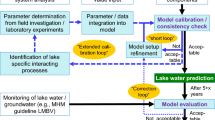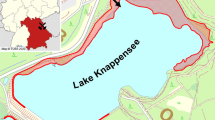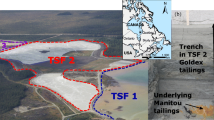Abstract
The formerly highly acidic pit Lake Bockwitz south of Leipzig (Germany) has been repeatedly treated since 2004 with soda ash to meet water quality criteria for the lake effluent. Intense monitoring of water quality parameters showed that previous predictions underestimated the acid load into the lake. Field research and lab experiments were designed to identify and quantify the processes responsible for re-acidification. Monitoring data and key parameters from intermittent-flow column experiments were integrated in hydrogeochemical and physical transport models. The combined lake budget model indicated that re-acidification was dominated by leaching of acidic sulfide mineral weathering products from the Tertiary bank substrates. High inputs of iron, aluminum, and sulfate were generated by infiltrating rain water, interflow, and groundwater recharge. In contrast, acid loads from surface runoff and soil erosion were minor at this particular site. Based on this work, a methodology is proposed to obtain critical parameters from field and lab investigations and integrate those into hydrogeochemical and physical transport models. These process-based models offer tools to reliably predict the water quality of mining pit lakes, develop appropriate treatment measures for the rehabilitation period, and plan the requirements for cost-effective lake water conditioning.
Zusammenfassung
Der vormals extrem saure Tagebaurestsee Bockwitz südlich von Leipzig (Deutschland) wurde seit 2004 wiederholt mit Natriumkarbonat behandelt mit dem Ziel, die für den Seeabfluss relevanten Wassergütekriterien sicher zu stellen. Basierend auf einem aufwendigen Wassergütemonitoring zeigte sich, dass die dem See zutretende Säurelast in den bisherigen Prognosen unterschätzt worden war. Um die für die Wiederversauerung des Tagebausees verantwortlichen Prozesse zu identifizieren und zu quantifizieren wurden Felduntersuchungen und Laborexperimente konzipiert. Monitoringdaten sowie aus diskontinuierlichen Säulenversuchen abgeleitete Schlüsselparameter wurden in hydrogeochemische und physikalische Transportmodelle integriert. Das komplexe Seehaushaltsmodell gab Hinweis darauf, dass die Wiederversauerung dominiert war durch den Eintrag von sauren Sulfidverwitterungsprodukten aus den tertiären Kippensubstraten. Starke Einträge von Eisen, Aluminium und Sulfat wurden hervorgerufen durch Niederschlagsinfiltration, Zwischenabfluss und Grundwasserneubildung. Dagegen waren die durch Oberflächenabfluss und Bodenerosion hervorgerufenen Säurelasten gering. Diese Arbeit schlägt auf Basis der Feld- und Laboruntersuchungen eine Methodik zur Ableitung entscheidender Prozessparameter vor, um diese für hydrogeochemische und physikalische Transportmodelle bereitzustellen. Diese prozessbasierten Modelle verfügen über Werkzeuge zur verlässlichen Vorhersage der Wasserqualität von Bergbaurestseen, zur Entwicklung von Behandlungsmaßnahmen in der Sanierungsphase sowie zur Planung der Voraussetzungen für eine kosteneffiziente Seewasserkonditionierung.
Resumen
El originalmente fuertemente ácido lago de pit Bockwitz al sur de Leipzig (Alemania) ha sido repetidamente tratado desde 2004 con carbonato de sodio para alcanzar el criterio de cualidad para lago de efluentes. El monitoreo de los parámetros de calidad del agua mostró que las predicciones previas subestimaron la carga ácida dentro del lago. Experimentos de laboratorio y trabajos de campos fueron diseñados para identificar y cuantificar los procesos responsables de la re-acidificación. Los datos del monitoreo y los parámetros relevantes de experimentos realizados en columnas de flujo intermitente fueron integrados en modelos hidrogeoquímicos y de transporte físico. El modelo indicó que la re-acidificación fue dominada por la lixiviación de productos de meterorización de minerales sulfurados. Altos niveles de entrada de hierro, aluminio y sulfato fueron generados por la infiltración de agua de lluvia, interflujo y recarga de agua subterránea. Por el contrario, las cargas ácidas por infiltraciones superficiales y erosión de suelo fueron menores en este sitio particular. Basándose en este trabajo, se propone una metodología para obtener los parámetros críticos desde el campo y desde investigaciones de laboratorio e integrarlas en modelos hidrogeoquímicos y de transporte físico. Estos modelos ofrecen herramientas para predecir adecuadamente la calidad del agua en lagos de pit mineros, desarrollar medidas de tratamiento apropiadas para el período de rehabilitación y planear los requerimientos para el acondicionamiento a costo adecuado del agua del lago.
抽象
为使德国莱比锡(Leipzig)南部Bockwitz矿坑湖高度酸性湖水达到排泄水质标准,该湖水自2004年以来已进行多次原位苏打中和处理。大量水质质测结果表明,以往的预测低估了进入湖水的酸性荷载。研究通过系列野外监测及室内试验识别和量化矿坑湖水的“再酸化re-acidification”过程。间歇式柱体淋溶试验数据及试验参数被引入水文地球化学及物质运移模型。湖水物质平衡模型计算结果表明,湖水再酸化过程主要受湖岸第三系基底硫化物酸性风化产物控制;同时,雨水渗入、壤中流排泄和地下水补给向矿坑湖输入大量铁、铝和硫酸盐,而地表径流及水土流失使湖水酸性荷载变化的作用较小。在上述研究基础上,提出由野外监测和室内试验获得关键参数并引入水文地球化学和物质运移模型的方法。该基于过程控制的模型有助于可靠预测矿坑湖水水质,合理选择湖水修复方法和有效规划湖水水质控制方案。







Similar content being viewed by others
References
Blodau C (2005) Groundwater inflow controls acidity fluxes in an iron rich and acidic lake. Acta Hydrochim Hydrobiol 33:104–117
Blodau C (2006) A review of acidity generation and consumption in acidic coal mine lakes and their watersheds. Sci Total Environ 369:307–332
Blodau C, Peiffer S (2002) Deposition and transformation of the iron mineral schwertmannite suppress the internal neutralization of lignite mining pit lakes. In: Deneke R, Nixdorf B (eds) Gewässerreport Nr. 7: Biogene Alkalinitäts produktion und Neutralisierung als ergänzende Strategie für die Restaurierung von extrem sauren Tagebauseen, Eigenverlag der BTU Cottbus, ISSN: 1434-6834, pp 81–87 [in German]
Bonacina C (2001) Lake Orta: the undermining of an ecosystem. J Limnol 60(1):53–59
LUA Brandenburg (ed) (2001) Open pit mine lakes: water quality and restoration in the sense of water quality management—concepts and operational experiences. Studien und Tagungsberichte, Schriftenreihe des Landesumweltamtes Brandenburg, Cottbus, Germany [in German]
Carmienke I, Guderitz I, Pokrandt KH (2011) Open pit mine lakes south of Leipzig—genesis, properties, and use [in German]. In: Röske I (eds) Wasserqualität in Standgewässern Sachsens, Abhandlg der Sächsischen Akademie d Wissenschaften zu Leipzig, Bd 65(4):18–43
Castendyk DN (2009) Conceptual models of pit lakes. In: Castendyk DN, Eary E (eds), Mine pit lakes—characteristics, predictive modeling, and sustainability, vol 3. Society for Mining, Metallurgy and Exploration, Littleton, pp 61–76
Castendyk DN, Webster-Brown JG (2007) Sensitivity analyses in pit lake prediction, Martha mine, New Zealand 2: geochemistry, water–rock reactions, and surface adsorption. Chem Geol 244:56–73
DGFZ (1998) Prognostic modeling of the water quality of Lake Bockwitz in the former open-cast mining district Borna-East/Bockwitz [in German] (unpubl). Dresdner Grundwasserforschungszentrum, by the order of LMBV mbH, Dresden, Germany
Fleckenstein JH, Neumann C, Volze N, Beer J (2009) Spatio-temporal patterns of lake-groundwater exchange in an acid mine lake. Grundwasser—Zeitschrift der Fachsektion. Hydrogeologie 14:207–217 [in German]
Grützmacher G, Hindel R, Kantor W, Wimmer R (2001) Chemical investigations of aquifers affected by pyrite oxidation in the Bitterfeld lignite district. Waste Manag 21:127–137
Guderitz I, Müller K, Bethge C, Neumann V, Nitsche C (2003) Limnological forecast on the pit lakes within the open-cast mining district Borna-East/Bockwitz [in German] (unpubl), by the order of LMBV mbH, Dresden, Germany, Dec 19, 2003
Haude W (1955) Determination of evapotranspiration by an approach as simple as possible. Mitt Dt Wetterdienst 2(11), Bad Kissingen (Dt Wetterdienst) [in German]
Heinrich B, Guderitz I, Neumann V, Pokrandt KH, Benthaus FC, Ulrich KU (2011) In-lake neutralisation and rehabilitation treatment of a lignite mining pit lake—lessons learned. In: Rüde TR, Freund A, Wolkersdorfer C (eds) Mine water—managing the challenges. Proceedings of the 13th IMWA Congress, Aachen, Germany, pp 343–347
Hoyningen-Huene JV (1983) Interception of precipitation in agricultural crops. Verlag Paul Parey, Hamburg, Berlin, Germany, DVWK-Schrift 57 [in German]
IBGW (2010) Modeling of ground—and surface water flow in the former open-cast mining district Borna-East/Bockwitz [in German] (unpubl). Ingenieurbüro für Grundwasser GmbH, by the order of LMBV mbH, Leipzig, Germany, Nov 1, 2010
Klapper H (1992) Eutrophierung und Gewässerschutz. Gustav Fischer Verlag Jena, Stuttgart
Knorr K-H, Blodau C (2006) Experimentally altered groundwater inflow remobilizes acidity from sediments in a iron rich and acidic lake. Environ Sci Technol 40:2944–2950
LMBV (2007) Mining-related hydrological monitoring of the LMBV mbH (MHM), code of practice of LMBV, Leipzig, Germany, Nov 2007 [in German]
Morin KA, Hutt NM (2009) On the nonsense of arguing the superiority of an analytical method for neutralization potential. MDAG.com internet case study #32, accessed April 2012. http://www.mdag.com/case_studies/cs32.html
Müller M, Eulitz K (2010) Characterizing water quality of a pit lake through modeling. In: Wolksersdorfer C, Freund A (eds) Proceedings of the IMWA symposium in mine water and innovative thinking, Sydney, NS, Canada, ISBN: 978-1-897009-47-5, pp 375–378
Müller M, Sames D, Mansel H (2003) PCGEOFIM—a finite volume model for more? In: Poeter E, Zheng C, Hill M, Doherty J (eds) Proceedings of the conference on MODFLOW and More 2003: understanding through modeling. Golden, CO, USA
Müller M, Werner F, Eulitz K, Graupner B (2008) Water quality modeling of pit lakes: development of a multiply-coupled groundwater lake circulation and chemical model. In: Rapantova N, Hrkal Z (eds) Proceedings of the 10th IMWA Congress. VSB-Technical Univ of Ostrava, Ostrava, Czech Republic, ISBN: 978-80-248-1767-5, pp 547–550
Müller M, Eulitz K, McCullough CD, Lund MA (2011) Model-based investigations of acidity sources and sinks of a pit lake in western Australia. In: Rüde TR, Freund A, Wolkersdorfer C (eds) Mine water—managing the challenges. Proceedings of the 13th IMWA Congress, Aachen, Germany, pp 41–46
Neumann V, Nitsche C, Tienz BS, Pokrandt KH (2007) Neutralisation of a large mining lake first-time by in-lake application—first experience from the onset of the rehabilitation period [in German]. In: Merkel B, Schaeben H, Wolkersdorfer C, Hasche-Berger A (eds) Treatment technologies for mining impacted waters, 58, Berg- und Hüttenmännischer Tag, Freiberg Wiss Mitt Inst Geol 35:117–124
Neumann V, Nitsche C, Pokrandt KH, Tienz BS (2008) Quantification of the acid load into a neutralized mining pit lake at the onset of the rehabilitation period [in German]. In: Merkel B, Schaeben H, Hasche-Berger A (eds) Treatment technologies for mining impacted waters, 59, Berg- und Hüttenmännischer Tag, Freiberg Wiss Mitt Inst Geol 37:73–80
Parkhurst DL, Appelo CAJ (1999) User’s guide to PHREEQC (version 2)—a computer program for speciation, batch-reaction, one-dimensional transport, and inverse geochemical calculations. USGS Report 99-4259, Denver, CO, USA
Redfield AC (1958) The biological content of chemical factors in the environment. Am Sci 46:205–221
Rönicke H, Schultze M, Neumann V, Nitsche C, Tittel J (2010) Changes of the plankton community composition during chemical neutralisation of the Bockwitz pit lake. Limnologica 40:191–198
Schmidt J (1996) Development and application of a physically founded simulation model of erosion from sloped arable land [in German]. Berliner Geographische Abhandlungen 61, Verlag des Institutes für geographische Wissenschaften, Berlin, Germany
Schultze M, Pokrandt KH, Hille W (2010) Pit lakes of the central German lignite mining district: creation, morphometry and water quality aspects. Limnologica 40:148–155 and Erratum, Limnologica 41:78
Šimůnek J, van Genuchten MT, Šejna M (2006) The hydrus software package for simulating the two- and three-dimensional movement of water, heat and multiple solutes in variably-saturated media. Technical manual, V 1.0, Prague, Czech Republic
Ulrich KU, Guderitz I, Menzel U, Heinrich B, Weber L, Pokrandt KH, Häfner K, Nitsche C (2011a) Quantification and prognosis of acid release from the sediment of a mining pit lake (Zwenkauer See) by means of field and laboratory experiments [in German]. Deutsche Gesellschaft für Limnologie (DGL) Erweiterte Zusammenfassungen der Jahrestagung (Bayreuth), Hardegsen, pp 167–172
Ulrich KU, Guderitz I, Heinrich B, Weber L, Pokrandt KH, Nitsche C (2011b) Long-term forecast of acidity load from overburden substrate into a mining pit lake: an integrated approach. Goldschmidt Conf Abstr Miner Mag 75(3):2048
Vandenberg JA, Lauzon N, Prakash S, Salzauler K (2011) Use of water quality models for design and evaluation of pit lakes. In: McCullough CD (ed) Mine pit lakes: closure and management. Australian Centre for Geomechanics, WA
Werner F, Bilek F, Luckner L (2001a) Implications of predicted hydrologic changes of Lake Senftenberg as calculated using water and reactive mass budgets. Mine Water Environ 20:129–139
Werner F, Bilek F, Luckner L (2001b) Impact of regional groundwater flow on the water quality of an old post-mining lake. Ecol Eng 17:133–142
Werner F, Eulitz K, Graupner B, Mueller M (2008) Pit lake Baerwalde revisited: comparing predictions to reality. In: Rapantova N, Hrkal Z (eds) Proceedings of the 10th IMWA Congress. VSB-Technical University of Ostrava, Ostrava, Czech Republic, ISBN: 978-80-248-1767-5, pp 623–626
Acknowledgments
This paper is dedicated to Karl-Heinz Pokrandt on the occasion of his retirement from the LMBV mbH; we acknowledge his commitment, persistent cooperation, and helpful support on many projects. The authors are indebted to all associates of the Lausitz and Central-German Mining Admin Company involved in this research. Special thanks are due to Eckhard Scholz, head of the Geotechnics department. We thank Bob Kleinmann and four anonymous reviewers for helpful suggestions on an earlier draft, and Thomas Voltz for linguistic improvements.
Author information
Authors and Affiliations
Corresponding author
Additional information
All papers published in this journal are initally published electronically; all subscribers can freely access the electronic versions, which sometimes contain additional tables and figures, using their membership number.
Electronic supplementary material
Below is the link to the electronic supplementary material.
Rights and permissions
About this article
Cite this article
Ulrich, KU., Bethge, C., Guderitz, I. et al. In-Lake Neutralization: Quantification and Prognoses of the Acid Load into a Conditioned Pit Lake (Lake Bockwitz, Central Germany). Mine Water Environ 31, 320–338 (2012). https://doi.org/10.1007/s10230-012-0206-4
Received:
Accepted:
Published:
Issue Date:
DOI: https://doi.org/10.1007/s10230-012-0206-4




